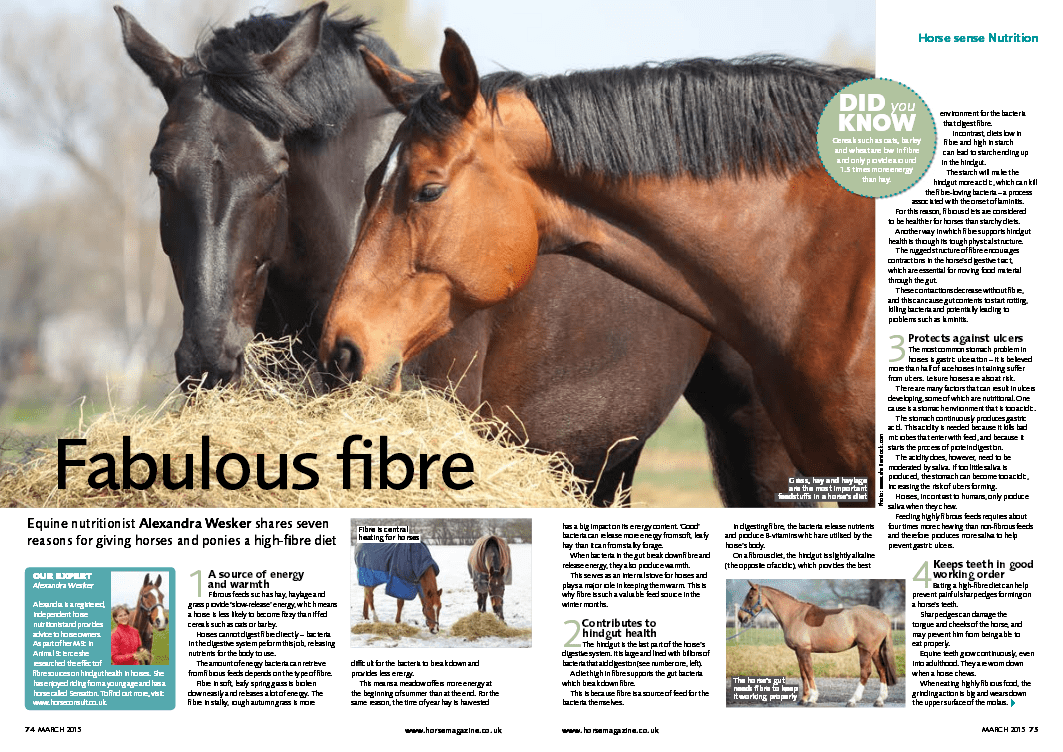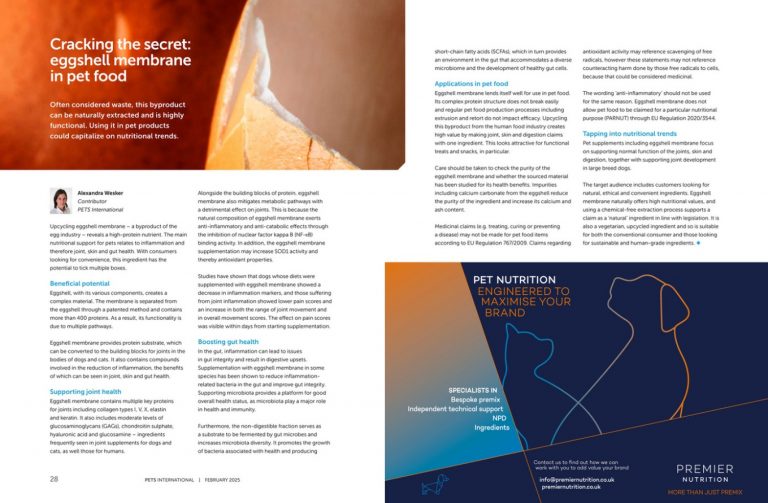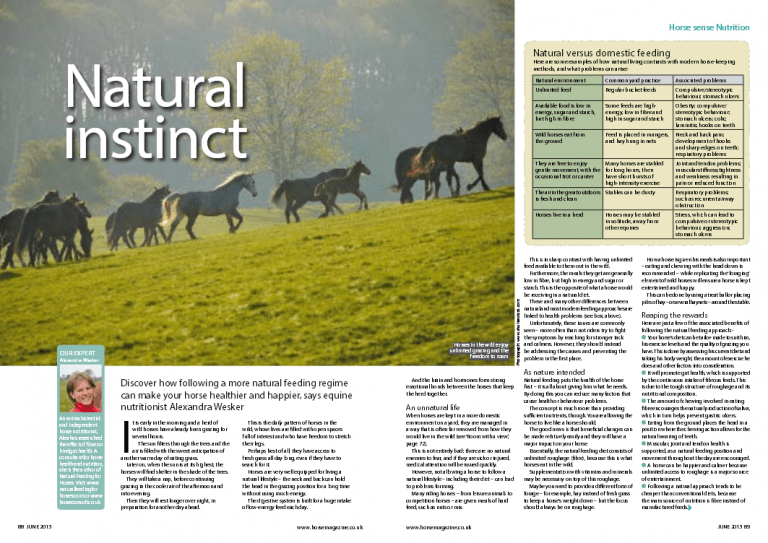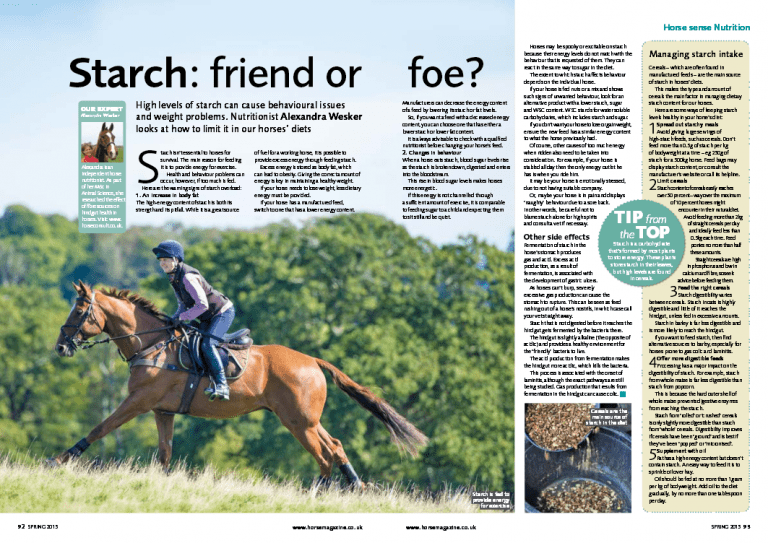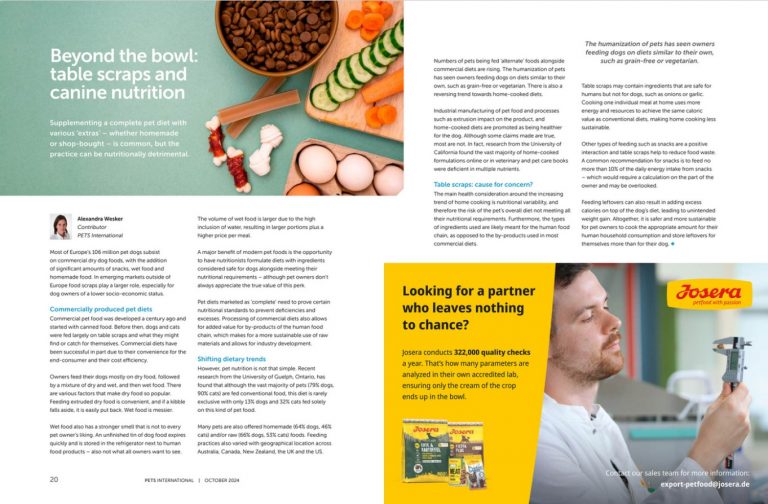Fabulous fibre
As published in Horse Magazine
Alexandra is a registered, independent horse nutritionist and provides advice to horse owners. As part of her MSc in Animal Science she researched the effect of fibre sources on hindgut health in horses. She has enjoyed riding from a young age and has a horse called Sensation.
Equine nutritionist Alexandra Wesker shares seven reasons for giving horses and ponies a high-fibre diet
Roughage is frequently regarded as ‘just in filler’ but gives many benefits in horse diets. This feature describes seven reasons for feeding horses high in fibre.
1. A source of energy and warmth
Fibrous feeds such as hay, haylage and grass provide ‘slow-release’ energy, which means a horse is less likely to become fizzy than if fed cereals such as oats or barley.
Horses cannot digest fibre directly – bacteria in the digestive system peform this job, releasing nutrients for the body to use.
The amount of energy bacteria can retrieve from fibrous feeds depends on the type of fibre.
Fibre in soft, leafy spring grass is broken down easily and releases a lot of energy. The fibre in stalky, rough autumn grass is more difficult for the bacteria to break down and provides less energy.
This means a meadow offers more energy at the beginning of summer than at the end. For the same reason, the time of year hay is harvested has a big impact on its energy content. ‘Good’ bacteria can release more energy from soft, leafy hay than it can from stalky forage.
When bacteria in the gut break down fibre and release energy, they also produce warmth.
This serves as an internal stove for horses and plays a major role in keeping them warm. This is why fibre is such a valuable feed source in the winter months.
2. Contributes to hindgut health
The hindgut is the last part of the horse’s digestive system. It is large and lined with billions of bacteria that aid digestion (see number one, left).
A diet high in fibre supports the gut bacteria which break down fibre.
This is because fibre is a source of feed for the bacteria themselves.
In digesting fibre, the bacteria release nutrients and produce B-vitamins which are utilised by the horse’s body.
On a fibrous diet, the hindgut is slightly alkaline (the opposite of acidic), which provides the best environment for the bacteria that digest fibre.
In contrast, diets low in fibre and high in starch can lead to starch ending up in the hindgut.
The starch will make the hindgut more acidic, which can kill the fibre-loving bacteria – a process associated with the onset of laminitis.
For this reason, fibrous diets are considered to be healthier for horses than starchy diets.
Another way in which fibre supports hindgut health is through its tough physical structure.
The rugged structure of fibre encourages contractions in the horse’s digestive tract, which are essential for moving food material through the gut.
These contractions decrease without fibre, and this can cause gut contents to start rotting, killing bacteria and potentially leading to problems such as laminitis.
3. Protects against ulcers
The most common stomach problem in horses is gastric ulceration – it is believed more than half of racehorses in training suffer from ulcers. Leisure horses are also at risk.
There are many factors that can result in ulcers developing, some of which are nutritional. One cause is a stomach environment that is too acidic.
The stomach continuously produces gastric acid. This acidity is needed because it kills bad microbes that enter with feed, and because it starts the process of protein digestion.
The acidity does, however, need to be moderated by saliva. If too little saliva is produced, the stomach can become too acidic, increasing the risk of ulcers forming.
Horses, in contrast to humans, only produce saliva when they chew.
Feeding highly fibrous feeds requires about four times more chewing than non-fibrous feeds and therefore produces more saliva to help prevent gastric ulcers.
4. Keeps teeth in good working order
Eating a high-fibre diet can help prevent painful sharp edges forming on a horse’s teeth.
Sharp edges can damage the tongue and cheeks of the horse, and may prevent him from being able to eat properly.
Equine teeth grow continuously, even into adulthood. They are worn down when a horse chews.
When eating highly fibrous food, the grinding action is big and wears down the upper surface of the molars.
However, when a horse munches on other feedstuffs that are non-fibrous, the chewing motion is small and only part of the tooth surface will be worn down.
The area of the tooth that is not worn down can become a sharp edge.
How you feed your horse his forage can also affect how he chews, and therefore how well his teeth are worn down. You should position his hay or haylage on the ground, whether feeding it in the field or in the stable.
Every horse should have at least an annual check up by a vet or qualified equine dental technician, even if he’s not showing signs of a mouth problem.
5. Provides healthy entertainment
It is natural for equines to eat for around 14 to 18 hours a day. However, modern living often sees horses individually stabled, and given a bucket feed one to three times a day.
Once the meal is finished they find other ways of entertainment, often in the form of unwanted behaviours such as cribbing, windsucking, weaving or twisting the tongue.
These behaviours have no constructive purpose but can cause health problems, and they are difficult – if not impossible – to undo.
Providing plenty of fibre for a horse to chew is a healthy way to keep him busy and prevent boredom, especially if it’s fed ‘ad lib’.
6. Acts as a water reserve
The hindgut of a horse serves as a reservoir for water and electrolytes.
During prolonged exercise – such as endurance races, or the cross-country phase of eventing – this reservoir is called upon and the horse will draw on the water and salt reserves it contains.
The horse’s diet plays a major role in how large the reservoir is.
When a horse eats lots of fibre, the hindgut will hold more fluids and electrolytes than if he’s on a low-fibre diet.
This is a main reason why the diets of endurance horses feature lots of fibre.
Most endurance riders take great care in selecting the right forage for their horses and tend to just feed that, alongside vitamin and mineral supplementation.
7. Supplies nutrients
A horse’s requirements for vitamins, minerals and trace elements are often met by fibrous feeds, provided they were produced on land which has good soil and are fed continuously (ad lib).
Overall, grass and hay tend to provide a good balance of nutrients. Fresh grass covers the vitamin A and E requirements for non-exercising horses in only a few hours of grazing.
Even grass with a low-energy content can deliver sufficient nutrients for non-exercising horses if fed ad lib.
Equally, unlimited grass with a high-energy content should meet the nutritional requirements of horses in work.
A further health benefit of grass is it contains fats that are omega-3 fatty acids. These are known to have anti-inflammatory effects.
Nutritional composition does, however, depend on the time of year.
For example, grass can provide good quality protein, but while levels are high during spring and summer, they are too low in autumn and winter to meet the needs of exercising horses.
Vitamin A and E content reduces when grass is made into hay.
Therefore, depending on the hay quality, a protein and vitamin supplement may be beneficial in winter.

